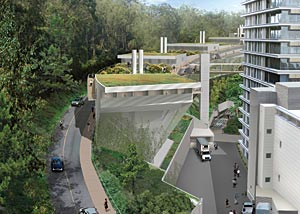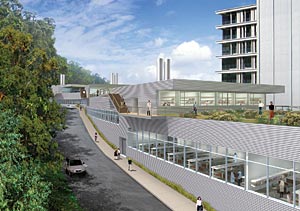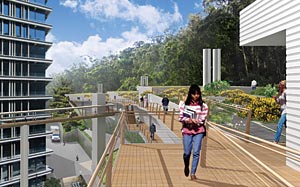


Images courtesy Rafael Viñoly Architects
For the University of California, San Francisco, Rafael Viñoly Architects has designed a stem cell research facility that features terraced volumes with green roofs. The project is partly funded by taxpayers in California, where $271 million is earmarked for construction of stem cell labs throughout the state. It’s “one of the largest building programs ever dedicated to a new field of medical science,” says Robert Klein, chairman of California Institute for Regenerative Medicine.
In August 2001, the Bush administration announced it was cutting off federal funding for most stem cell research. Three years later, in November 2004, defiant Californians responded by passing Proposition 71: an initiative that directed $3 billion toward stem cell research at state universities and nonprofit research institutions, and established an oversight agency, the California Institute for Regenerative Medicine (CIRM).
Part of the funding was earmarked for facility construction, and at last that money is getting spent. On May 7 the CIRM announced it was allocating $271 million to build stem cell research labs throughout California. The agency’s chairman Robert Klein described it as “one of the largest building programs ever dedicated to a new field of medical science.” The funds were distributed among 12 institutions that contributed, in total, an extra $560 million. Architectural firms from around the country have been tapped to design the labs, from the seven-person Davis Davis Architects in San Diego, California, to the 100-person Pei Cobb Freed & Partners, based in New York. The building streak will create 800,000 square feet of research space, and all projects should be completed and occupied within two years.
“A lot of these institutions had projects they wanted to do, but the grant money was integral to their financing,” explains Josh Schroeder, AIA, project director at Rafael Viñoly Architects (RVA). The New-York based firm was commissioned to design a 74,000-square-foot facility for the University of California, San Francisco (UCSF), which received a $34.8 million grant. The Institute for Regeneration Medicine Building, as it’s called, was relegated to a challenging site: an uneven parcel on the hilly south side of campus. RVA responded by effectively creating a new site, laying isolated foundations and elevating the structure. A curved series of terraced volumes will follow the slope, and inside, four split-levels will offer “a seemingly endless lab condition,” Schroeder says. “Stacking a lab building is potentially easier,” he explains, “but you end up stratifying your users.” The design also features a ribbon of windows that looks out toward a eucalyptus forest. RVA is targeting a LEED Silver rating for the project.
For its stem cell facility, Stanford University brought in Zimmer Gunsul Frasca Architects (ZGF), which also is designing stem cell labs at the University of Southern California and the University of California, Berkeley. The four-story structure ZGF has imagined for the Stanford’s School of Medicine—awarded $43.6 million, the most of any recipients—will consolidate researchers who are now spread between labs both on and off campus. It also features an open plan intended to foster interdisciplinary interactions, explains ZGF partner Joe Collins, AIA. “We want flexible spaces,” Collins says, “because we don’t know which way the research will turn, and we want to find ways to create convenient collisions between people.”




Post a comment to this article
Report Abusive Comment